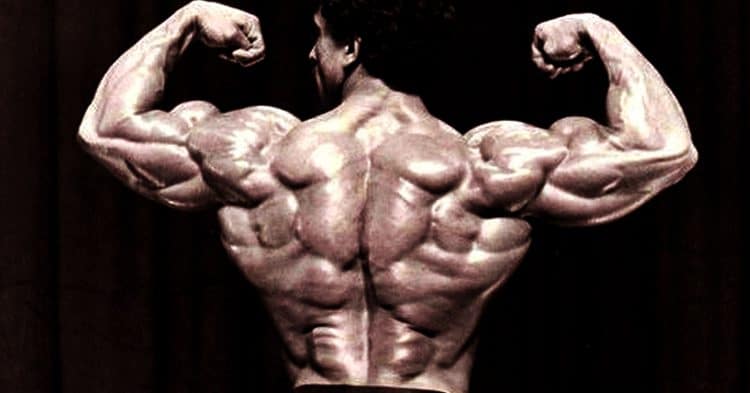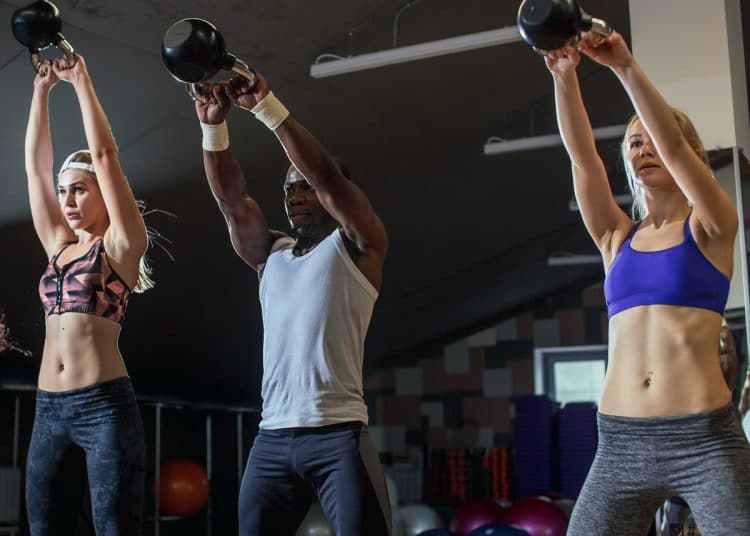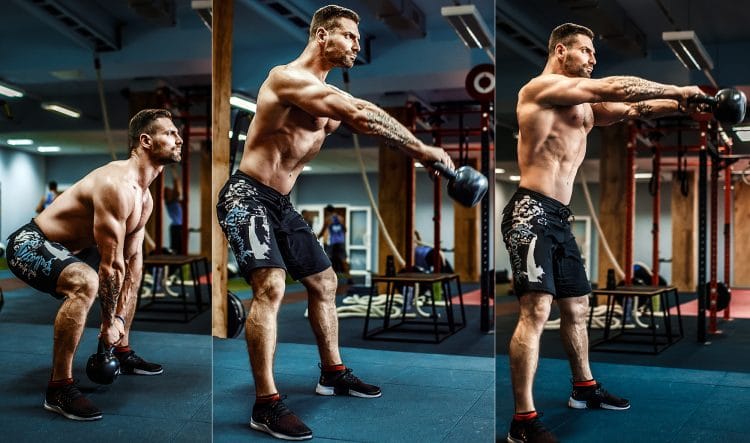Everyone loves a good chest or abs workout. After all, these are the muscles you can see in the mirror. However, the muscles on the back of your body are arguably more important. After all, these are the muscles that hold you up against the pull of gravity.
Focusing too much on the front of your body and neglecting your back can cause all sorts of problems, from poor posture to muscle imbalances that increase your risk of injury. Also, if you don’t want to look good from the front and lousy from behind, back training is a must.
Pull-ups, chin-ups, T-bar rows, and other popular back exercises can all help build the back of your dreams, but you can use kettlebells too.
In this article, we reveal the 12 best kettlebell back exercises and provide you with THREE back-building workout programs to follow.
Back Anatomy


Your back is an extensive group of muscles. If you want a big, strong, healthy back, you need to make sure you train all of these muscles equally. The main muscles you need to develop to build your dream back are:
Erector spinae – this is the collective name of the muscles that run up either side of your spine. The erector spinae helps stabilize and support your lower back to prevent it from rounding. It is also responsible for the extension and lateral flexion of your spine. Strong erector spinae muscles can help prevent lower back pain.
Latissimus dorsi – known as the lats for short, this is the large wing-like muscle located on the side of your upper back. Its functions are shoulder extension, adduction, and medial rotation. The lats give your upper back its width and help create a V-shaped torso. Well-developed lats are visible from the back AND the front.
Trapezius – the traps are a large, diamond-shaped muscle that covers much of your upper back. It’s made up of three distinct sections:
- Upper traps – responsible for shoulder girdle elevation, i.e., shrugging your shoulders.
- Middle traps – responsible for shoulder girdle retraction, i.e., pulling your shoulders back.
- Lower traps – responsive for shoulder girdle depression, i.e., pulling your shoulders downward.
Rhomboids – this lesser-known back muscle is located beneath your mid-traps and between your shoulder blades. Its primary function is the retraction of your shoulder girdle. The rhomboids don’t contribute much to the size of your back, but they’re vital for posture and shoulder girdle stability.
Posterior deltoids – while not strictly a back muscle, the posterior deltoids are heavily involved in most horizontal pulling exercises. They’re also a vital postural muscle. If you want to build the best-looking, most functional back possible, you also need to pay attention to your posterior deltoids.
Revealed! The 12 Best Kettlebell Back Exercises
While there is nothing wrong with a steady diet of barbell, dumbbell, and machine back exercises, using other training methods could be just what’s needed to keep your workouts fresh, interesting, and productive.
Spice up your workouts with the 12 best kettlebell back exercises!
1. kettlebell Renegade Row

Renegade rows are not just a great back builder; they’re a superb full-body exercise! This move works your lats, mid-traps, rhomboids, and posterior deltoids and involves your legs and core too. Combine renegade rows with push-ups for a really time-efficient workout.
Check out our in-depth guide to doing renegade rows.
2. Elevated Plank Bent-over Row
While renegade rows are undeniably a great exercise, they’re not for everyone. For starters, you need two kettlebells, and you’ll also need excellent wrist strength to support your weight on one arm. This kettlebell back exercise is somewhat easier, and you only need one weight to do it. However, it’s still a very effective movement.
How to do it:
- With a kettlebell in one hand, place your other hand on a knee to hip-high bench or step. Keeping your supporting arm straight, walk your feet back and into a plank position. Brace your abs and let the weight hang down from your shoulders, which should be pulled down and back.
- Without lifting or lowering your hips or twisting your body, bend your arm and row the kettlebell up and into your ribs.
- Extend your arm and repeat.
- Try to do the same number of reps on each side.
3. Unsupported Single-arm Bent-over Row
When most people do single-arm rows, they place their free hand on a nearby exercise bench for support. While this may mean you can lift more weight, it also takes your erector spinae out of the exercise. Work your entire back by doing this exercise without external support.
How to do it:
- Hold a kettlebell in one hand and stand with your feet about shoulder-width apart. Bend your knees slightly for balance. Pull your shoulders down and back, and brace your core.
- Hinge forward from your hips until your upper body is inclined to about 45-degrees. Let your arms hang down from your shoulders. Do not round your lower back.
- Without twisting your hips or shoulders, bend your arm and row the weight up and into your ribs.
- Extend your arm and repeat.
- Do the same number of reps on each side.
4. Kettlebell Wrestler’s Row
This exercise is very useful for those times where you only have access to light kettlebells. It keeps your muscles under tension for longer so that even light weights feel much more challenging. Like all rowing exercises, this move works your lats, mid-traps, rhomboids, and posterior deltoids. It’s done without support, so your erector spinae are also involved.
How to do it:
- Hold a kettlebell in each hand and stand with your feet about shoulder-width apart. Bend your knees slightly, brace your core, and pull your shoulders down and back.
- Lean forward from your hips until your body is inclined to about 45-degrees. Do not round your lower back. Pull both weights up and into your ribs. This is your starting position.
- Keeping one arm stationary, lower and then row the weight back up to your side.
- Repeat on the opposite side.
- Continue alternating arms for the duration of your set.
5. Single-arm Deadlift
Deadlifts are one of the best back-building exercises around. They’re also fantastic for increasing total body strength. Generally done with a barbell, you can also do deadlifts with a kettlebell. Using just one weight means you’ll have to work extra hard to stabilize your spine, increasing core and lower back activation in the process.
How to do it:
- Place your kettlebell on the floor. Stand astride it with your feet about shoulder-width apart. Squat down and grab the handle with an overhand grip. Straighten your arm, pull your shoulders down and back, brace your hips, lift your chest, and slightly arch your lower back.
- Drive your feet into the floor and stand up, using your lats to keep the weight close to your legs.
- Lower the kettlebell back to the floor and repeat.
6. Kettlebell Swing
Kettlebell swings work virtually every muscle on the back of your body, from the nape of your neck to your heels. As well as being an excellent strength training exercise, kettlebell swings are also a useful conditioning tool and can help you build fitness and burn fat too.
Learn how to do kettlebell swings with this informative form guide.
7. Two-handed Kettlebell High Pull

The two-handed kettlebell high-pull is a variation of barbell sumo deadlift high-pull. Using a kettlebell makes this exercise more accessible and requires less space, making it ideal for home exercisers. High pulls work all of your back muscles, especially your traps and erector spinae.
How to do it:
- Place your kettlebell on the floor. Stand astride it with your feet about shoulder-width apart. Squat down and grab the handle with both hands using an overhand grip. Straighten your arm, pull your shoulders down and back, brace your hips, lift your chest, and slightly arch your lower back.
- Stand up quickly and use this momentum to help you pull your kettlebell up the front of your body and up to your chin. Lead with your elbows and keep them above your hands. Shrug your shoulders upwards to maximize upper trap recruitment.
- Lower the weight down to your hips, and then return it to the floor.
- Reset your core and repeat.
- You can also do this exercise from the “hang position,” i.e., with the weight at knee-height and not resting on the floor.
8. Single-arm High Pull
Doing high pulls with one arm forces you to stabilize your spine to avoid being pulled off-balance. This increases core and erector spine activation. This option is useful for those times when you only have a light kettlebell to train with. Perform as above but use just one arm instead of two and pull the weight up to your shoulder instead of your chin.
9. Alternating Bent-over Fly
This simple but effective exercise works your middle traps, rhomboids, posterior deltoids, and erector spinae. You won’t need a lot of weight for this one; even a light kettlebell will deliver a great workout.
How to do it:
- Hold a kettlebell in one hand. Stand with your knees slightly bent, feet about shoulder-width apart. Lean forward from your hips, so your upper body is inclined to about 45-degrees. Do not round your lower back. Let your arms hang down from your shoulders.
- Raise the kettlebell out and up to the side until your arm is roughly parallel to the floor.
- Lower your arm, transfer the weight to your opposite hand, and repeat.
- Continue alternating sides for the duration of your set.
10. Single-arm Clean
Cleans are one of the Olympic lifts and are traditionally done using a barbell. The single-arm kettlebell version forces you to stabilize your spine more and is also easier to learn. Like all types of clean, this exercise is a total back builder.
- Place your kettlebell on the floor. Stand astride it with your feet about shoulder-width apart. Squat down and grab the handle with both hands using an overhand grip. Straighten your arm, pull your shoulders down and back, brace your hips, lift your chest, and slightly arch your lower back.
- Stand up quickly and use this momentum to help you pull your kettlebell up the front of your body.
- As the weight approaches your shoulder, flip it over so that it comes to rest on the back of your forearm. (From what I’ve gathered talking about this movement, in particular, is that typically, a safer way to do this is to spin the kettlebell around the wrist to rest on the forearm rather than flipping it on the forearm)
- Lower the weight back to the floor and repeat.
- You can also do this exercise from the “hang position,” i.e., with the weight at knee-height and not resting on the floor.
11. Single-arm Snatch
The snatch is another Olympic lift. It’s a tricky exercise to master, but the good news is that the kettlebell version is a lot more manageable. Like cleans (exercise #9), kettlebell snatches work all of your back muscles.
How to do it:
- Place your kettlebell on the floor. Stand astride it with your feet about shoulder-width apart. Squat down and grab the handle with both hands using an overhand grip. Straighten your arm, pull your shoulders down and back, brace your hips, lift your chest, and slightly arch your lower back.
- Stand up quickly and use this momentum to help you pull your kettlebell up the front of your body and lift it overhead in one movement.
- Catch the weight above your head, letting the kettlebell flip over your hand (same thing from previous suggestion), and come to rest on the back of your forearm.
- Lower the weight back down to the floor and repeat.
- You can also do this exercise from the “hang position,” i.e., with the weight at knee-height and not resting on the floor.
12. Incline Overhead Press
Pressing exercises usually work your chest or shoulders. This unusual movement works your back instead. Start off with a light weight; this exercise is much harder than it looks!
How to do it:
- Hold your kettlebell in front of your chest by the vertical handles. Stand with your feet about hip-width apart, knees slightly bent. Lean forward until your upper body is at about a 45-degree angle. Do not round your lower back. Brace your abs and pull your shoulders down and back.
- Without lifting or lowering your torso, press the weight forward and up so that your arms form a straight line with your body.
- Return the weight to your chest and repeat.
Kettlebell Back Workouts
While there is nothing to stop you from just adding a few kettlebell exercises to your current bodybuilding program, you may get better results if you follow a kettlebell back workout. Design your own or use one of our tried-and-tested workouts.
Remember to spend a few minutes warming up before you begin any of these workouts. A few minutes of light cardio, followed by some dynamic stretches and joint mobility exercises, will suffice. Finish your warm-up with 2-3 light sets of the exercises you are about to do.
Workout 1 – 3 x 3
In a hurry? This is the workout for you! It consists of three exercises, each of which is done for three sets. Do the three exercises as a giant set, moving quickly from one to the next. Rest 1-2 minutes between laps. In 15 minutes or less, you’ll have trained your entire back. Do 8-12 reps of each exercise.
- Kettlebell swing
- Wrestler’s row
- Incline overhead press

Workout 2 – Row for glory!
This workout is all about rows. Focusing more on rows than pulldowns and pull-ups will add thickness to your upper back and could also improve your posture. Do 8-12 reps of each exercise, resting 60-90 seconds between sets. Do 2-4 sets of each exercise.
- Renegade row
- Wrestler’s row
- Elevated plank bent-over row
- Unsupported single-arm row
Workout 3 – Strength and power
Use heavy kettlebells to build a stronger, more muscular back. Do 2-4 sets of 4-8 reps, resting 2-3 minutes between each one.
- Single-arm snatch
- Single-arm cleans
- Single-arm high pulls
- Single-arm deadlifts
- Two-handed high pull
Wrapping Up
There is nothing inherently wrong with barbell, dumbbell, body weight, or machine exercises. In fact, they’re all-but essential if you want to build the body of your dreams. That said, your body likes variety, and changing up your workout from time to time can help maintain your progress and avoid ruts and plateaus.
Add something new to your back-building workouts with these 12 kettlebell exercises. They’re tried, tested, and certified effective. Not convinced? Try one of our kettlebell back programs. You’ll soon discover just how effective kettlebells can be for building muscle size and strength.
